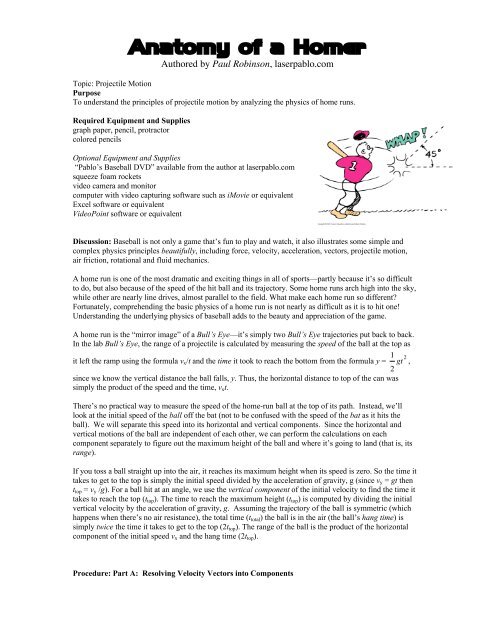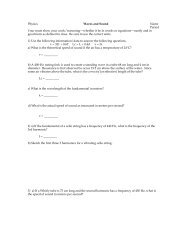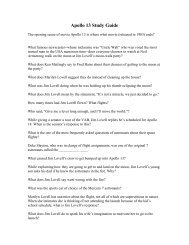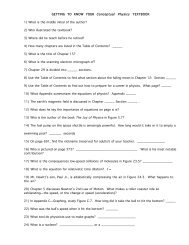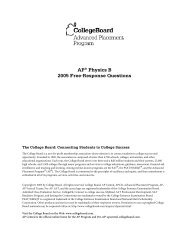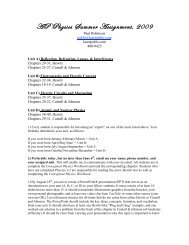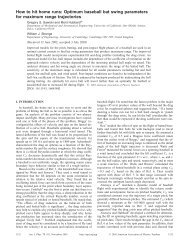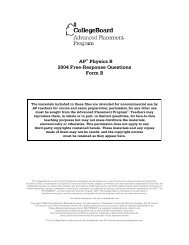Anatomy of a Homer - Pablo's Physics
Anatomy of a Homer - Pablo's Physics
Anatomy of a Homer - Pablo's Physics
You also want an ePaper? Increase the reach of your titles
YUMPU automatically turns print PDFs into web optimized ePapers that Google loves.
<strong>Anatomy</strong> <strong>of</strong> a <strong>Homer</strong><br />
Authored by Paul Robinson, laserpablo.com<br />
Topic: Projectile Motion<br />
Purpose<br />
To understand the principles <strong>of</strong> projectile motion by analyzing the physics <strong>of</strong> home runs.<br />
Required Equipment and Supplies<br />
graph paper, pencil, protractor<br />
colored pencils<br />
Optional Equipment and Supplies<br />
“Pablo’s Baseball DVD” available from the author at laserpablo.com<br />
squeeze foam rockets<br />
video camera and monitor<br />
computer with video capturing s<strong>of</strong>tware such as iMovie or equivalent<br />
Excel s<strong>of</strong>tware or equivalent<br />
VideoPoint s<strong>of</strong>tware or equivalent<br />
Discussion: Baseball is not only a game that’s fun to play and watch, it also illustrates some simple and<br />
complex physics principles beautifully, including force, velocity, acceleration, vectors, projectile motion,<br />
air friction, rotational and fluid mechanics.<br />
A home run is one <strong>of</strong> the most dramatic and exciting things in all <strong>of</strong> sports—partly because it’s so difficult<br />
to do, but also because <strong>of</strong> the speed <strong>of</strong> the hit ball and its trajectory. Some home runs arch high into the sky,<br />
while other are nearly line drives, almost parallel to the field. What make each home run so different?<br />
Fortunately, comprehending the basic physics <strong>of</strong> a home run is not nearly as difficult as it is to hit one!<br />
Understanding the underlying physics <strong>of</strong> baseball adds to the beauty and appreciation <strong>of</strong> the game.<br />
A home run is the “mirror image” <strong>of</strong> a Bull’s Eye—it’s simply two Bull’s Eye trajectories put back to back.<br />
In the lab Bull’s Eye, the range <strong>of</strong> a projectile is calculated by measuring the speed <strong>of</strong> the ball at the top as<br />
it left the ramp using the formula v x /t and the time it took to reach the bottom from the formula y = 1 2 gt 2 ,<br />
since we know the vertical distance the ball falls, y. Thus, the horizontal distance to top <strong>of</strong> the can was<br />
simply the product <strong>of</strong> the speed and the time, v x t.<br />
There’s no practical way to measure the speed <strong>of</strong> the home-run ball at the top <strong>of</strong> its path. Instead, we’ll<br />
look at the initial speed <strong>of</strong> the ball <strong>of</strong>f the bat (not to be confused with the speed <strong>of</strong> the bat as it hits the<br />
ball). We will separate this speed into its horizontal and vertical components. Since the horizontal and<br />
vertical motions <strong>of</strong> the ball are independent <strong>of</strong> each other, we can perform the calculations on each<br />
component separately to figure out the maximum height <strong>of</strong> the ball and where it’s going to land (that is, its<br />
range).<br />
If you toss a ball straight up into the air, it reaches its maximum height when its speed is zero. So the time it<br />
takes to get to the top is simply the initial speed divided by the acceleration <strong>of</strong> gravity, g (since v y = gt then<br />
t top = v y /g). For a ball hit at an angle, we use the vertical component <strong>of</strong> the initial velocity to find the time it<br />
takes to reach the top (t top ). The time to reach the maximum height (t top ) is computed by dividing the initial<br />
vertical velocity by the acceleration <strong>of</strong> gravity, g. Assuming the trajectory <strong>of</strong> the ball is symmetric (which<br />
happens when there’s no air resistance), the total time (t total ) the ball is in the air (the ball’s hang time) is<br />
simply twice the time it takes to get to the top (2t top ). The range <strong>of</strong> the ball is the product <strong>of</strong> the horizontal<br />
component <strong>of</strong> the initial speed v x and the hang time (2t top ).<br />
Procedure: Part A: Resolving Velocity Vectors into Components
Step 1: To get an idea about the relative importance <strong>of</strong> the initial speed and the direction the ball is struck,<br />
draw velocity vectors that represent the ball’s speed just as it leaves the bat at various angles. Suppose a<br />
slugger strikes a ball so that it leaves the bat at 180 ft/s. Use the scale 1 cm = 10 ft/s to make velocity<br />
vectors. Draw all the vectors so they all have their tails on the same point, the first vector at zero degrees,<br />
the second vector at 15 degrees, etc., up to 90°. To help make each vector clearly visible, draw each vector<br />
using a different colored pencil.<br />
Step 2: Now sketch the components <strong>of</strong> each velocity vector using dashed lines. Remember, this velocity<br />
vector represents the initial velocity <strong>of</strong> the ball. Remember, just as in the lab Bull’s Eye, the vertical<br />
components will decrease due the acceleration <strong>of</strong> gravity whereas the horizontal ones won’t.<br />
Step 3: Make a table <strong>of</strong> v x and v y for the various angles.<br />
Analysis<br />
1. Which ball goes the highest?<br />
2. At what angle is the ball going fastest horizontally?<br />
3. At what angle is the horizontal component the same as the vertical component?<br />
4. At what angle does the ball go farthest? Why?<br />
Procedure: Part B: Dissecting a <strong>Homer</strong><br />
Let’s analyze some <strong>of</strong> the physics involved when a batter hits a homer. First, we need to make some<br />
assumptions. To keep things simple, we will neglect the effects <strong>of</strong> air friction or drag. Suppose the batter<br />
hits a 95-mi/h fastball at 120 mi/h at an angle <strong>of</strong> 38 degrees. Let’s do some calculations and see how high<br />
the ball goes and where it lands. To make this problem more familiar, we’ll use units <strong>of</strong> feet and<br />
feet/second instead <strong>of</strong> meters and meter/second. To convert mi/h to ft/s, recall that there are 5280 feet in a<br />
mile and 3600 seconds in an hour. Therefore, 1 mi/h = 5280 ft/3600 s or approximately 1.47 ft/s.<br />
Step 1: Convert the 120 mi/h into ft/s. Use the conversion factor <strong>of</strong> 1 mi/h = 1.47 ft/s. Show your<br />
conversion and record your result.<br />
120 mi/h = (120 mi/h) (1.47 ft/s) = ____________ ft/s<br />
(mi/h)<br />
Step 2: Choose a scale (such as a 1 cm = 10 ft/s) so that your velocity vector will occupy a large portion <strong>of</strong><br />
your graph paper. Write down the scale you choose.<br />
scale: ____________<br />
Then use your scale to calculate the length <strong>of</strong> the velocity vector that represents the initial velocity <strong>of</strong> the<br />
ball. Record your calculations.<br />
length <strong>of</strong> velocity vector = _________<br />
Step 3: Use a protractor to draw the initial velocity vector on your graph paper. Then carefully sketch the<br />
horizontal and vertical components <strong>of</strong> the initial velocity using dashed lines.<br />
Step 4: Measure the length <strong>of</strong> the horizontal components vx <strong>of</strong> the ball’s initial velocity. Then convert this<br />
measurement into ft/s. Record your measurement and calculation.<br />
v x = ________ cm = __________ ft/s<br />
Step 5: Repeat this procedure to find the ball vertical component <strong>of</strong> the ball’s initial velocity.<br />
v y = ________ cm = __________ ft/s
Analysis<br />
Now that we know the ball’s initial horizontal and vertical velocities for both the pitch and the hit, we can<br />
calculate some interesting things about the ball’s trajectory.<br />
The Pitch:<br />
How long does it take a ball going 95 mi/h to reach home plate? The distance from the pitcher’s mound to<br />
home plate is 60.5 ft. Show your calculations.<br />
Assuming the ball is pitched parallel to the ground, how far does it fall due to gravity by the time it reaches<br />
the plate? Show your calculations.<br />
The <strong>Homer</strong>:<br />
5. How long does it take for the ball to reach its maximum height (t top )?<br />
6. How long is the ball in the air? (That is, what is the hang time? Remember, hang time = 2t top )?<br />
7. What is the maximum height <strong>of</strong> the ball?<br />
8. How far does the ball land down range?<br />
9. What are the two most important factors that determine how far a batted ball will go? (The speed<br />
and the angle <strong>of</strong> the ball the ball as it leaves the bat.)<br />
10. Do your answers seem reasonable? What does your answer to Question #4 support or refute about<br />
the assumption that the effects <strong>of</strong> air friction can be neglected?<br />
11. Why do baseballs travel farther at Coors Field in Denver, Colorado?<br />
12. Why are most homers not hit at angles greater than 50 degrees?<br />
Going Further: The Effects <strong>of</strong> Friction<br />
Step 1: Try to launch the foam rocket with the same force each time. This may take several trials to<br />
become a consistent “launcher”. Launch a foam pop rocket at various angles. Devise a technique for<br />
estimating the angle the rocket was launched.<br />
Step 2: Using a video or camcorder, make a recording <strong>of</strong> the rocket’s trajectory when launched at the<br />
angle that results in the maximum range. Position a meterstick vertically in the background to give you<br />
a way to measure the height <strong>of</strong> the rocket in the video. It is helpful to choose a plain background to<br />
make viewing the rocket’s path easier.<br />
Step 3: After obtaining a video <strong>of</strong> the rocket, import the video clip into a computer program using<br />
videocapturing s<strong>of</strong>tware such as iMovie. Play it back onto a monitor frame by frame. Most video<br />
cameras take a frame every 1/30 th <strong>of</strong> a second. If available use VideoPoint s<strong>of</strong>tware; it will make<br />
analyzing the trajectory very easy.<br />
Step 4: Construct a data table <strong>of</strong> the rocket’s height vs. time. Record the data collected from the video<br />
analysis <strong>of</strong> the rocket launch. Plot your data as a line graph on graph paper, or alternatively, use a<br />
spreadsheet program, such as Excel®, on a computer, to produce the data table and graph. Print your<br />
data table and graph. You should be able to produce a smooth curve <strong>of</strong> the trajectory <strong>of</strong> the ball.
13. What angle results in the greatest horizontal range?<br />
14. Is the trajectory <strong>of</strong> the rocket a symmetric parabola?<br />
15. What is causing the trajectory to diverge from a parabola?<br />
Step 5: View the video <strong>of</strong> Barry Bonds hitting home runs. Observe the angle <strong>of</strong> the ball as it leaves<br />
the bat. In the absence <strong>of</strong> friction, the maximum range <strong>of</strong> a projectile is when it is hit at 45 degrees.<br />
Analysis<br />
16. Are most <strong>of</strong> Bonds’ homers at or near 45 degrees?<br />
17. You’ll notice that most <strong>of</strong> the homers hit are at 45 degrees to the horizontal or less—sometimes<br />
much less. Some are barely 25 degrees. Explain.<br />
18. In the lab What a Drag, you tested two models <strong>of</strong> friction; one in which the friction varies as the<br />
speed and another in which the friction varies as the square <strong>of</strong> the speed. What were your results from<br />
the lab? (If you have not done the lab, this would be an excellent time to do so!) Summarize your<br />
results below.


